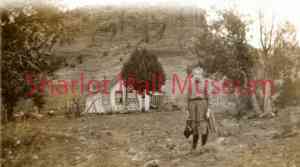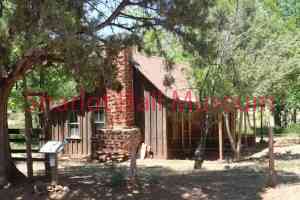By Nancy Burgess
The primary purposes of the Homestead Act of 1862 were twofold: to make government owned land available to citizens and to open up the western United States to settlement. This act paved the way for United States citizens of any means to obtain land at no cost other than the fee to file the paperwork.
Homesteading in Arizona Territory was slow to develop as much of the territory was completely undeveloped, and therefore inaccessible – a “wilderness.” Even the territorial capitol of Prescott was established in a wilderness in 1864.
 Johann Georg Heinrich (Henry) Schuerman was born in Hanover, Germany in 1852. He came to the United States about 1872 and was in Prescott, Arizona Territory by 1884, where he and his cousin George Schuerman owned the Sherman House hotel on north Cortez Street. Henry had begun a lengthy correspondence with a childhood friend in Hanover, Karoline Dorothe (Dorette) Titgemeier. When he proposed marriage, she accepted, and they both traveled to New York City where they were married in 1884.
Johann Georg Heinrich (Henry) Schuerman was born in Hanover, Germany in 1852. He came to the United States about 1872 and was in Prescott, Arizona Territory by 1884, where he and his cousin George Schuerman owned the Sherman House hotel on north Cortez Street. Henry had begun a lengthy correspondence with a childhood friend in Hanover, Karoline Dorothe (Dorette) Titgemeier. When he proposed marriage, she accepted, and they both traveled to New York City where they were married in 1884.
Henry was not a farmer but what he wanted to do was to grow grapes and make wine. To do that, he, of course, needed land. He took title to 160 acres of land in “Red Rock” in settlement for a debt. Red Rock is the area south of Highway 89A and west of the Sedona city limits, in the area of the Red Rock Loop Road, still known today as “Red Rock.”
 Henry had never seen the land. It was an un-surveyed, unsettled wilderness in the middle of nowhere, but there was water. As granddaughter Martha Loy wrote, Henry and his wife did not want to stay because there were “no roads, no schools or churches. It was beautiful, but so wild and strange to them. They did not want to stay. They could not even give it away. No one wanted it. What could they do with it? They just stayed, as they did not know where else to go.” So, Henry and Dorette settled on this 160 acres in “Red Rock,” started an orchard, planted grapes, built a stone house and a winery and started a family of six children.
Henry had never seen the land. It was an un-surveyed, unsettled wilderness in the middle of nowhere, but there was water. As granddaughter Martha Loy wrote, Henry and his wife did not want to stay because there were “no roads, no schools or churches. It was beautiful, but so wild and strange to them. They did not want to stay. They could not even give it away. No one wanted it. What could they do with it? They just stayed, as they did not know where else to go.” So, Henry and Dorette settled on this 160 acres in “Red Rock,” started an orchard, planted grapes, built a stone house and a winery and started a family of six children.
In 1902, Henry “proved up” on a homestead. To do this, he had to build and occupy a home, prepare the ground for crops, irrigate the land and farm it successfully for five years. At the end of the five years he could apply for a Homestead Deed, which would be issued to him by the President of the United States.
In about 1907, he began the process to “prove up” on a second homestead. This 40 acres, which he “proved up”, was deeded to him in 1913. It was flat and arable and there was water from Oak Creek. He and his sons built a house, put in a pumping system and dug the “Red Rock Ditch” to supply water from Oak Creek. They had dairy cows and raised cattle and horses, grew produce, including strawberries and melons, and fruit, primarily apples and peaches. The zinfandel grapes did well and they made wine. Henry had contracts to supply wine to various businesses, which he did until and after Prohibition, which started in 1915 in Arizona, and which ended in a jail sentence for Henry.
 Henry died in 1920 and Dorette in 1940. Today, the 40-acre 1913 homestead has been broken up into smaller parcels. A small 8/10ths of an acre parcel, which includes the house, pumphouse and a portion of the Red Rock Ditch, has been deeded by Henry and Dorette’s granddaughter to the Sedona Historical Society for eventual use as a homestead museum.
Henry died in 1920 and Dorette in 1940. Today, the 40-acre 1913 homestead has been broken up into smaller parcels. A small 8/10ths of an acre parcel, which includes the house, pumphouse and a portion of the Red Rock Ditch, has been deeded by Henry and Dorette’s granddaughter to the Sedona Historical Society for eventual use as a homestead museum.
Nancy Burgess,an historian and photographer specializing in the history of central Arizona, is preparing a nomination to the National Register of Historic Places for the Schuerman Homestead, now the property of the Sedona Historical Society.
“Days Past” is a collaborative project of the Sharlot Hall Museum and the Prescott Corral of Westerners International (www.prescottcorral.org). This and other Days Past articles are also available at archives.sharlothallmuseum.org/articles/days-past-articles/1 The public is encouraged to submit proposed articles and inquiries to dayspast@sharlothallmuseum.org Please contact SHM Research Center reference desk at 928-277-2003, or via email at archivesrequest@sharlothallmuseum.org for information or assistance with photo requests.


